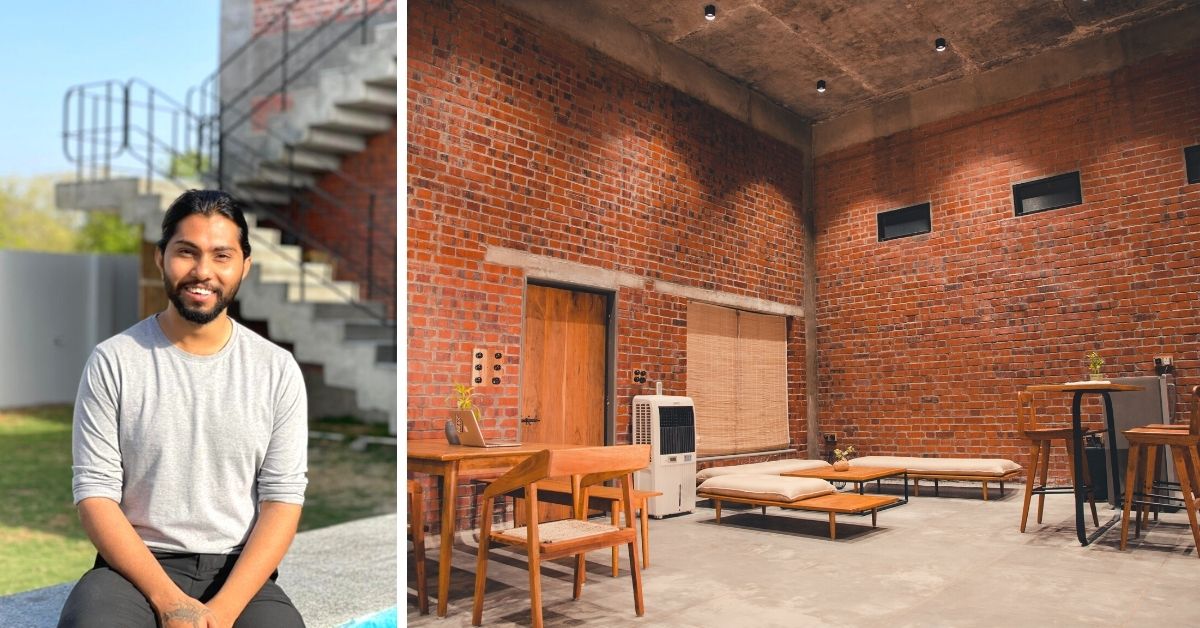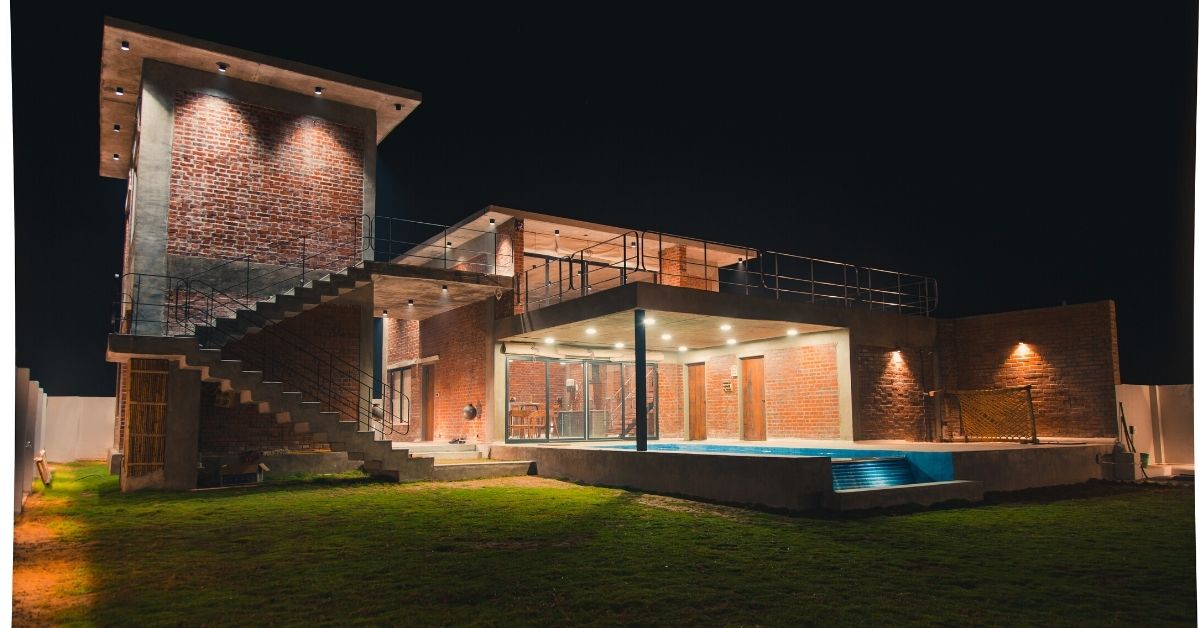Ancient Tradition & Physics Keeps This Rajasthan Home 8 Degrees Cooler Than Outside
How to build a sustainable home that stays cool in Rajasthan's scorching summers? Find out all about ideas like Kota stone, eco-friendly cement alternatives and zero tile construction from Raghu Pratap Singh of Tatvam Jaipur

In March 2020, Raghu Pratap Singh, a Jaipur-based architect, accompanied his cousin to their property in Achrol, Rajasthan, which is about a 30-km drive from the city.
His cousin, Heena Sukhani and her family, wanted to sell their unused property and asked him to tag along to suggest his architectural views. Raghu was immediately impressed with the location and recommended that the family build ‘something unique’ to gain from it.
The family temporarily parked the thought of selling their property. Coincidentally, the visit happened around 18 March 2020, after which a nation-wide lockdown began.
A few weeks later, Raghu presented an eco-friendly design of a house to his family. “My extended family was impressed and gave me the approval to go ahead with the idea as it was economical too,” the 26-year-old says.
Raghu built an eco-friendly house that harvests thousands of litres of water, has zero use of tiles and plaster. The house used 40 per cent less cement against the conventional requirement. He even implemented innovative designs to keep the house cooler. The result? The house remains cool by 8℃ in the Rajasthan heat even as the temperatures outside peak up to 50℃ in summers.
Magic Of Physics

Raghu tells The Better India that he created the house for his passion for building sustainable properties. “I completed an interior and architecture design degree in 2018. I was impressed with sustainable architecture, a subject taught during my academic years. The thought of using natural resources and reducing the need for artificial amenities always motivated me to find sustainable solutions,” he says.
Raghu adds that not many decades ago, the wadas from Maharashtra and Southern India, the Havelis in Jaipur and Gujarat, stone houses in Ladakh and other Himalayan regions intrigued him. “These architectural marvels show us the efficient use of natural resources for sustainable living. I always feel fascinated and inspired by the same and try to apply it in my work,” he says.
Raghu says through his firm, Tatvam Jaipur, he created the house, Tatvan Vas, inclusive of two bedrooms, a living room, kitchen, swimming pool and two baths. The house spreads across 6,500 sq feet.
Sharing his insights on his eco-friendly concepts, Raghu says, “The construction required 300 bags of cement instead of the 500 or more. We used egg yolks and marble powder for the binding purpose, which helped reduce the overall requirement of cement. There is no layering of the structure. Terracotta bricks have been used during its construction, ensuring climate-responsive behaviour.”
Raghu says the hollow spaces between the bricks ensure the indoor temperatures remain cooler during summers and warmer during the winter months.
“The house plan is designed utilising adequate cross ventilation. The sunlight hits all the rooms, eliminating the need for using external sources in the daytime,” he says, adding that the arrangement ensures that electricity is not required during the day, which saves energy.
Raghu explains, “The sun travels east to west via the south, thereby the major heat gain and the direct sunlight falls in the south-west direction. The space planning has been executed such that most of the living quarters face north with minimum exposure to the sun. The set up reduces the heat gain of the building and helps us cope with the hot climate of Rajasthan. This becomes a natural temperature controlling system.”
He further adds that understanding the wind patterns and paths helped in controlling the temperatures through natural ways.

“According to Bernoulli’s principle, an increase in speed of fluids or air leads to a decrease in pressure. So if we blow hot air through narrow passages, the temperature falls. The use of jaali in Rajasthan applies the same concept. We applied this theory at Tatvam Vas in the corridor space between the bedroom and living room that provides substantial cross ventilation. Another way of harnessing the wind was to have the same-size windows facing each other to amplify ventilation,” he says.
Additionally, Raghu says, a buffer space is kept around the periphery of the entire building to facilitate air movement in the interior and exterior. “The built-up area is away from the boundary to provide enough space for regulating wind and air. The detailed layout ensures that the temperature lowers significantly in the process,” he adds.
A Swimming Pool That Recycles Water
Raghu adds that significant steps have been taken to use natural materials for aesthetic purposes. “From the flooring to the colour pigmentation, various techniques have been applied to fulfil the purpose precisely with their best suited natural alternatives,” he says.
“Kota stone, a naturally occurring material, has been used in the bathroom and exterior spaces. Heavy use of iron was done in places such as the stairway and upper deck formation. Brass has been used delicately to provide expansion joints [a joint filler between flooring blocks]. Instead of opting for tiles, we used the science from indigo dyes to naturally colour the pool by conceiving a mortar mix. The indigo dye makes the pool appear blue without the application of paint or any other surface layer,” he says.
Raghu adds that most of the furniture is carved out of Sheesham and acacia, babool wood. All doors have used up-cycled wood extracted from old gates discarded from various heritage properties around the city.
As an element choice, they decided to go for bamboo chic curtains. “All materials are sourced from the proximity of the site to avoid increasing the carbon footprint and keep the process vernacular,” Raghu says.
The property also has a rainwater harvesting project that stores 6,000 litres of water which is used for gardening and domestic purposes.
“The same water is used to fill the water level of the pool that gets evaporated over time. The swimming pool water is reused with advanced filtration technology. The pool water is recyclable for up to four to six years,” he adds.

Raghu says another feature that he focussed on is sanitary waste management. “We devised a system that collects the solid waste to a cesspit installed underground, which converts it to compost. Also, the liquid waste generated in the kitchen and bathing area is recycled through a septic tank method,” he adds.
Ganesh Gulve, an architect who mentored Raghu through the project, says, “The approach taken by Raghu was out of the box. He was brave to experiment with these concepts. Sensitivity towards sustainability is of utmost importance to carry out such projects.”
He adds that adopting convenient options is simpler, instead of looking for challenging approaches. One should opt for environment-friendly and low-carbon footprint options to serve their needs.
Raghu’s cousin, Heena — a fashion and textile designer, says she is glad about the way the property has turned out in a year’s time. “We did not see an opportunity for the plot earlier but when Raghu proposed the concept, this became a potential long-term investment option,” she says.
She adds, “The stay gives an experience of vibrancy and subtleness,” she adds.
Raghu says, “The approach towards the project was not only based on aesthetics but also the utility of the materials and vernacular elements. The ecological aspects blend effortlessly in a manner crafted out of nature and science.”
Edited by Yoshita Rao
If you found our stories insightful, informative, or even just enjoyable, we invite you to consider making a voluntary payment to support the work we do at The Better India. Your contribution helps us continue producing quality content that educates, inspires, and drives positive change.
Choose one of the payment options below for your contribution-
By paying for the stories you value, you directly contribute to sustaining our efforts focused on making a difference in the world. Together, let's ensure that impactful stories continue to be told and shared, enriching lives and communities alike.
Thank you for your support. Here are some frequently asked questions you might find helpful to know why you are contributing?


This story made me
-
97
-
121
-
89
-
167














